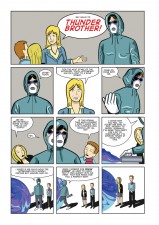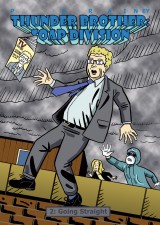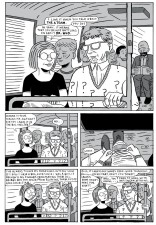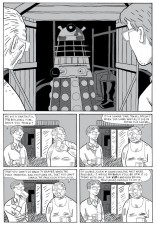 The recent publication of Paul B. Rainey’s sprawling time-travel epic There’s No Time Like the Present by Escape Books gives much deserved recognition to one of the true mainstays of the UK small press scene. Rainey has been creating and self-publishing comics since the 1980s, including the popular Book of Lists, TNTLTP, and Thunder Brother: Soap Division. The latter was reviewed here at ‘Small Pressganged’ last year.
The recent publication of Paul B. Rainey’s sprawling time-travel epic There’s No Time Like the Present by Escape Books gives much deserved recognition to one of the true mainstays of the UK small press scene. Rainey has been creating and self-publishing comics since the 1980s, including the popular Book of Lists, TNTLTP, and Thunder Brother: Soap Division. The latter was reviewed here at ‘Small Pressganged’ last year.
Rainey’s work often places relatable protagonists against a backdrop of the fantastic and unworldly though his back catalogue is remarkably diverse in terms of the subject matter covered. With that beautifully produced hardcover compilation of the thirteen issues of There’s No Time Like the Present officially launched this month I took some time to chat with Paul about his genre-merging comics, how his work came to Escape, and the complexities of cross-time commuting…
 ANDY OLIVER: You had quite a traditional entry point into comics as a child. How did that love of weekly comics inform the kind of work you would produce years later as a self-publisher?
ANDY OLIVER: You had quite a traditional entry point into comics as a child. How did that love of weekly comics inform the kind of work you would produce years later as a self-publisher?
PAUL B. RAINEY: With weekly strips, being delivered in short bursts, I felt like I was only being exposed to aspects of broader worlds at a time and therefore felt I had no choice but to savour them. It was like being drip fed and having to enjoy every bite. If my first exposure to comics had been big finished works like Blankets or The Sculptor, for example, I might have found the thought of creating my own graphic novel insurmountable. Even though my graphic novel, There’s No Time Like The Present, is constructed to be exactly that, a complete whole, knowing that I could put it together by working on it a scene at a time made the job significantly less intimidating.
You’ve been an active and stalwart presence in the UK small press for over two decades. What are the most significant changes you’ve seen on the scene in that time?
There are a lot more women making comics now. And a lot more events. In general, I notice, that organisers of even the more mainstream events understand for them to be successful they need to accommodate the small press comic artist and their audience. Whenever I encounter events that don’t understand this, it’s always a surprise to me.
Anyone who has been following the back-ups in your Thunder Brother: Soap Division series will have an idea of how you embrace a wide variety of genres within your comics practice – from Shakespearean sonnets in comics form to slice-of-life work like ‘Dear Robert and Partner’ (recently reprinted in ILYA’s The Mammoth Book of Cult Comics) through to your work in Viz. Could you give us an overview of your comics resumé to date?
I drew a spoof superhero comic strip for a weekly local paper for around a year during the Eighties called Fly Guy. Then some friends and I ran a local arts magazine for a couple of years called The Spot, which I drew humour strips for. During the Nineties, I wrote, drew and published six issues of my post-modern superhero comic, Memory Man. I then re-launched it as an anthology (an anthology drawn entirely by me and not starring Memory Man) called Love Bomb which lasted only two issues. (A third issue was drawn but never published).
One of Paul’s recent Pope Francis strips, his Love Bomb comic of yesteryear, and last year’s The Mammoth Book of Cult Comics which includes some of his work
Once the twenty-first century came along, I started posting panels from my diary comic every day to my website. That was called Book of Lists. After doing this for a few years, I published a full-colour book collection. (Currently out of print). Towards the end of BoL, I took a year-long career break and started work on There’s No Time Like The Present which, ten years later, has just been beautifully published by Escape Books. More recently, I’ve completed eight Thunder Brother: Soap Division stories, only six of which have been self-published, and had the occasional strip appear in Viz, after twenty-seven years of submitting work to them.
Sample pages from Thunder Brother: Soap Division
I recently reviewed your current self-published project Thunder Brother: Soap Division at Broken Frontier. It’s a comic with an endearingly idiosyncratic mix of science fiction and in-jokes about current UK soap operas. What most attracts you in storytelling terms about the possibilities of merging genres in the playful way you do in Thunder Brother?
Thunder Brother has had a long gestation. Originally, it was a story about a boy who travels from one end of the country to the other to save a character in a soap that he is attracted to who, at the end of that week’s episode, is held hostage during a siege. The twist was going to be that once the boy arrives, he exposes the soap as actually being real. I was about to run a variation of that idea in Love Bomb when I was devastated to read about The Truman Show and realised that the two ideas were very similar. After I saw the film, I felt that they what they did with what I believe to be a common-conceit, was very obvious, so I revisited my idea and what I wanted to do with it. And that became Thunder Brother: Soap Division.
Once I had the idea fully worked out, I realised that I had an opportunity to express my feelings and thoughts about the work place, the work ethic and how I feel that the majority are seen by broader society as resources to be used up, exhausted and discarded, which only mashing-up the genres would provide for me. But I also placed strict limits on how the stories are created. For example, each episode is twelve pages long and each page is written and drawn one at a time, what I refer to as seat-of-your-pants writing, so as to ensure that they are, primarily, entertaining.
Currently, the strip is on hiatus. Upon reflection, it is probably more ambitious than even There’s No Time Like The Present and I had to ask myself if I want to work on something for possibly another ten years or more with little or no feedback. Which is a shame because I would love to do more.
 There’s No Time Like the Present is a series that you worked on for quite a number of years. How did the collected edition come to Escape Books?
There’s No Time Like the Present is a series that you worked on for quite a number of years. How did the collected edition come to Escape Books?
When I finished serialising the story over thirteen issues, I emailed a handful of people I know with greater success and experience than me to ask for advice on approaching publishers with it. One of these people was Paul Gravett, the publisher of Escape Books, who replied saying that they would like to publish it. I was speechless. I was a big fan of Escape Magazine during the Eighties (I started buying it with issue four) and the thought of my first graphic novel being published by the same people who had published the first comic-work by creators like Dave McKean, Neil Gaiman and Eddie Campbell broke my brain. They’ve had a really good hit rate, I would say.
As the most recent self-published creator to be picked up by a UK publisher do you have a sense of graduation from the world of small press comics now that a potentially far wider audience is imminent?
I wouldn’t say that I feel like I have graduated because I still have a proper job that makes me unhappy. However, having people invest in you and present your work in such a way that exceeds your ability and expectations has done a lot for my self-esteem. It’s a big change from my comics existing only because of my sheer bloody-mindedness. But it has happened at the right time for me. I had grown demoralised by the process of draw comic, publish comic, attend event, sit behind table and be mainly ignored, go home, count how much money you’ve lost. Any events I do now, I feel like I’m sharing the weight of, and that means that the ones I attend are lot more fun for me again.
An example of Paul’s more satirical comics work. Check out his blog for many more strips in this vein…
There’s No Time Like the Present has such a sprawling narrative that it’s very difficult to sum it up in a succinct paragraph or two. To give some context could you give the Broken Frontier readers a brief idea of the book’s premise and explain your rather unique take on time travel?
When I sold the singles at events I always described it this way; “It’s about a group of friends with varying degrees of nerd tendencies and their relationships. It’s set in what appears to be the real world except that time travel exists, the characters can download movies from the future for example. That tiny science fiction conceit itches away in the background, growing bigger and bigger.”
I always found the argument that time travel can’t ever be invented because otherwise we would have been visited by people from the future by now dismissive. In TNTLTP, it’s only possible to travel as far back in time to the first day that it’s invented. You need both a transmitter and a receiver. The story is told from the point of view of members of the last generation who were alive before the invention of time travel.
Covers from the original singles run of TNTLTP
In both Thunder Brother and TNTLTP very relatable everyperson characters are placed against a backdrop of the utterly fantastic. Do you feel that the extremes of that contrast emphasises the humanity of your cast?
Telling stories from the point of view of exceptional people doesn’t really interest me. For example, the story of the person who invents time travel or the Prime Minister who oversees the great changes that happen from it would be very different to the one that ended up being There’s No Time Like The Present. I’m far more interested in how seemingly regular people live with this great change and the disconcerting impact that it has upon their lives. All sorts of opportunities for interesting themes to explore present themselves, I find.
There are some wonderful comedic set pieces revolving around nerd culture in TNTLTP. Some of the characters preparing to essentially grave rob someone’s comic collection, for example, or a great moment with a life-size Dalek being used to heckle a public speaker. For all their pop cultural obsessions the cast of TNTLTP are all characters we connect with and feel fully invested in. Was there an element of demystifying the geek to the book?
I think it’s curious that we can associate someone having an interest in one thing as being socially maladjusted and another thing as being perfectly normal. Why is it that somebody who slavishly supports the same football team for all of their life regardless of who is playing for them and how well they are doing isn’t thought of as suffering from a disorder of some sort? Meanwhile, somebody who likes Star Trek: Deep Space Nine but doesn’t like Star Trek: Enterprise is considered to be incapable of exercising critical ability.
Interiors from There’s No Time Like the Present…
One of my earliest discarded scenes from the story sees the characters attend a Sci-Fi Convention on a Sunday morning. I wanted to observe that they were up early when all the “cool” people their age were asleep in bed nursing their hangovers. To somebody like me who has lived through years of lost Sundays, this felt life affirming and positive to me. I think I wanted to be celebratory about people I felt associated with but not necessarily one of.
Given the way in which we observe the characters at different points in their lives in There’s No Time Like the Present and the sense of retrospective reflection that exists within its pages would you say, that for all its sci-fi trappings, “seize the day” idea was the book’s overarching message?
I’ve felt a sense of urgency all of my life but never known what it is a feel so urgent about. Also, because the book took so long to finish and it, like many of my previous big projects, was so involving, there have been impacts upon my non-comic life. Perhaps one of the things the story is analogous to is the impact of the effort and focus that I was putting into making it.
A taster from one of Paul’s Eric Pickles parody strips. More available online here
One of the central themes that really interested me was this notion that in the world of TNTLTP everything has changed in one sense and yet, in another very real one, nothing has. People become trapped by their own destinies. There’s a pronounced element of fatalism. Was the idea of investigating the conflict between free will and determinism one of the central themes that you set out to explore?
I remember the morning after the attacks on the Twin Towers in New York and The News telling us that the world will never be the same again and thinking “how is my life different now?” and actually it probably wasn’t. These characters live in a world where this incredible thing has been discovered, time travel, and yet their lives continue to be as uneventful and dull as before. If anything, now their lives are a little worse. In my lifetime, the Internet, a real and incredible thing, has come into common usage and yet I feel just as dissatisfied now as I did before. I might be able to back-up my entire record collection to Google Play and stream it from anywhere but, really, it’s a distraction from what we know is important, whatever that is.
Given how many years it took to publish all the individual issues of TNTLTP did the plot you have in mind evolve during that process? How rigid was your story structure throughout or did it become more organic and fluid as time went on?
When I started, I knew the opening scene, I knew the sign-posts in the story and I knew the final scene. I knew that it was going to take me a long time to finish (although not as long as it did) and being over familiar with it would make writing and drawing it feel laborious very soon, so I allowed myself a lot of flexibility and room for spontaneity between the signposts. The details of the story revealed themselves to me in a very satisfying way I found.
Further sample pages from There’s No Time Like the Present…
What kind of revisions or edits did it undergo as a collection when it came to Escape?
Some of the characters had their appearances slightly redrawn for consistency. I changed some of the dialogue so that specific scenes worked better. I also drew an extra page in the final section of the book so that scene made more sense. When the story was originally serialised as singles, the artwork was straight black and white. For the collection, I toned the artwork, which took several months to complete, and it looks a lot better for it, I think.
And finally, now that the handsome hardcover edition of TNTLTP is out there on the shelves, what’s next for Paul B. Rainey? What upcoming projects can you give us teasers for?
It’s very early days but I’ve started work on a strip, the working title of which is Why Don’t You Love Me? I’m unsure of what form it will appear to the world in yet, though. I want to get a few more pages finished first so that I feel satisfied that the way I am writing and drawing it can support the story that I’m trying to tell.
For more on Paul B. Rainey’s work visit his website here and follow him on Twitter here. His online store can be found here and you can also buy There’s No Time Like the Present from the Escape Books website here.
For regular updates on all things small press follow Andy Oliver on Twitter here.


































